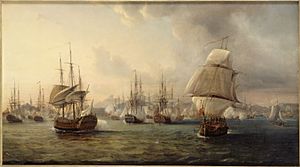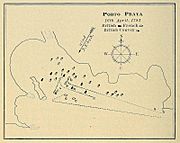Battle of Porto Praya facts for kids
Quick facts for kids Battle of Porto Praya |
|||||||
|---|---|---|---|---|---|---|---|
| Part of the American Revolutionary War | |||||||
 Combat de la baie de la Praia dans l'île de Santiago au Cap Vert, le 16 avril 1781, by Pierre-Julien Gilbert (1783–1860) |
|||||||
|
|||||||
| Belligerents | |||||||
| Commanders and leaders | |||||||
| George Johnstone | Bailli de Suffren | ||||||
| Strength | |||||||
| 5 ships of the line | 5 ships of the line | ||||||
| Casualties and losses | |||||||
| 36 killed 147 wounded |
93 killed 217 wounded |
||||||
The Battle of Porto Praya was a surprise naval battle. It happened on April 16, 1781, during the American Revolutionary War. A British fleet led by Commodore George Johnstone fought a French fleet. The French were commanded by Bailli de Suffren.
Both fleets were sailing towards the Cape of Good Hope in Africa. The British wanted to capture it from the Dutch. The French aimed to protect it and their own lands in the Indian Ocean. The British ships had stopped at Porto Praya (now Praia) in the Cape Verde Islands for water. Suddenly, the French fleet arrived and attacked them while they were anchored.
Neither side was fully ready for a fight. The battle was confusing and didn't have a clear winner. The French ships took more damage than the British. No ships were completely lost by either side. Johnstone tried to chase the French, but his ships needed too many repairs.
The French won a strategic victory. Suffren reached the Cape of Good Hope first. He helped the Dutch defend it. Then he continued his journey to the Île de France (now Mauritius).
Why the Battle Happened
France joined the American Revolutionary War in 1778. Britain declared war on the Dutch Republic in late 1780. This was because the Dutch kept trading with France and America. So, the British ordered Commodore Johnstone to capture the Dutch colony at the Cape of Good Hope.
On March 13, 1781, Johnstone sailed from Spithead. His fleet had 37 ships. This included five large warships called ships of the line. There were also three smaller frigates and many troop transport ships. In early April, the fleet stopped at Porto Praya. This was a neutral harbor in the Portuguese-controlled Cape Verde Islands. They needed to get water and supplies.
Meanwhile, Suffren was on a mission for France. He was sent to help French and Dutch colonies in India. He commanded a fleet of five ships of the line. He also had seven transport ships and a smaller warship called a corvette. On March 22, he sailed with another French fleet. This other fleet was going to North America. Suffren knew about Johnstone's mission. His goal was to reach the Cape of Good Hope first.
One of Suffren's ships, the Artésien, needed water. So, the French fleet paused near Santiago on April 16. Suffren ordered the Artésien to head into the harbor.
The Battle Begins
When the Artésien reached the mouth of the harbor, its crew saw the British fleet. They quickly signaled Suffren that the enemy was there. Suffren guessed correctly that the British sailors would be on shore. He knew they would be in disarray. So, he immediately ordered an attack. He led the way with his main ship, the Héros.
Commodore Johnstone was busy moving his ships. They had drifted too close to each other. When the French appeared, he had to quickly get his fleet ready for battle. It was a scramble!
Suffren's plan was for his ships to anchor in front of the British fleet. Then they would open fire. He did this with Héros. His ship attacked Hero and Monmouth. These were the two biggest British ships. The Annibal soon joined the fight. It took most of the enemy fire.
The Artésien captured a British merchant ship called Hinchinbrooke. Its captain was killed early in the fight. Then a breeze blew the Artésien away from the main action. The Vengeur sailed past the British ships. It fired its cannons but never anchored. It soon moved out of the battle. The Sphinx also failed to anchor. It only helped a little in the fight.
Suffren had the advantage of surprise. He kept fighting with his two anchored ships for 90 minutes. But his ships were getting damaged. The Annibal lost two of its three masts. So, Suffren signaled for his fleet to retreat. They kept firing as they left. The Annibal lost its last mast as it left the harbor. It was very slow to follow the Héros.
The French captured four British ships. These included two large merchant ships called East Indiamen. They were the Hinchinbrook and the Fortitude. They also captured the fireship Infernal and the supply ship Edward. However, the British managed to get all of them back in the next few days.
Aftermath
After the battle, Suffren gathered his fleet outside the harbor. They needed to check for damage and make repairs. Two British ships, Terror and Infernal, had gotten out to sea. The French fired on them. The Terror caught fire but escaped. Its crew put out the flames. The French captured the Infernal. They took its captain, Henry Darby, and some sailors as prisoners.
Johnstone got his fleet ready. He left the harbor to chase the French about three hours later. Suffren arranged his ships in an aggressive line. Johnstone's ships, especially Isis, had been badly damaged. So, he decided not to fight again. He returned to the harbor to fix his ships.
Before he returned, Johnstone got the Infernal back. Its remaining crew had recaptured it. This happened when the French prize crew (the sailors guarding the captured ship) were not paying attention. Or, the French prize crew might have just abandoned it when the British fleet approached. The French prize crews also left the Hinchinbrook and Edward. The British recovered these ships a few days later.
Suffren's fleet reached the Cape of Good Hope on June 21. His troop transports arrived nine days later. He stayed there for a month to repair and refit his ships. He left 500 men to help defend the Dutch colony. Then he continued his journey to Ile de France. Johnstone still headed for the Cape. He arrived in July. At Saldanha Bay, he captured five Dutch East Indies ships. After that, he sailed back to England.
Legacy
A French submarine, La Praya (S 622), was later named in honor of this battle. It was an Agosta-class submarine.



